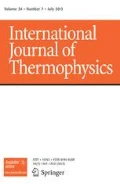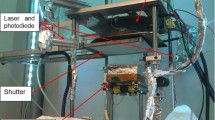Abstract
Estimation of thermal conductivity of charring composite is a key issue for both design and optimization of an ablative thermal protection system. This paper presents a method for predicting temperature-dependent thermal conductivity of charring ablator using genetic algorithm and cubic spline interpolation, and a special ablative material composed of phenolic resin, glass fibers and quartz fibers is concerned. In this study, by considering the effects of pyrolysis, carbon–silica reaction, and the convective heat transfer between pyrolysis gas and charred layer, the ablative heat transfer model is developed to simulate the ablation process first. Then based on the measured temperature profiles and built model, the temperature-dependent thermal conductivity without prior information on the functional form is predicted which is parameterized by cubic spline. The predicted thermal conductivity curve is continuous and smooth everywhere, and the changes of the curve can reveal the ablation characteristic of the concerned material precisely. Consequently, the calculated temperature profiles using the predicted results show good agreement with experimental data. Also, the reliability of the prediction is discussed through analyzing the iterative process and the number of interpolation nodes. It is concluded that the improvement is limited through adding nodes when the thermal conductivity is already well defined by existing nodes.












Similar content being viewed by others
Abbreviations
- A :
-
Pre-exponential factor, s−1
- \({B}{^{\prime}}\) :
-
Non-dimensional mass flux
- \({c}_{p}\) :
-
Specific heat capacity, J·kg−1·K−1
- E :
-
Activation energy, J·mol−1
- h :
-
Specific enthalpy, J·kg−1
- k :
-
Thermal conductivity, W·m−1·K−1
- \(\dot{m}\) :
-
Mass flux, kg·m−2·s−1
- n :
-
Order of reaction
- Q :
-
Reaction heat J·kg−1
- q :
-
Heat flux W·m−2
- R :
-
Ideal gas constant J·mol−1·K−1
- St :
-
Stanton number
- T :
-
Temperature, K
- \({T}_{r}\) :
-
Reaction temperature, K
- t :
-
Time, s
- u :
-
Velocity, m·s−1
- \({v}_{w}\) :
-
Surface ablation rate, m·s−1
- x :
-
Stationary coordinate
- α :
-
Absorptivity
- ε :
-
Emissivity
- ρ :
-
Density, kg·m−1
- σ :
-
Stefan–Boltzmann constant, W·m−2·K−1
- 0 :
-
Initial status
- c :
-
Fully charred
- cond :
-
Conduction
- conv :
-
Convection
- e :
-
Boundary layer edge
- f :
-
Final status
- g :
-
Gas
- i :
-
The ith reaction; the ith nodes
- rad :
-
Radiation
- w :
-
At the surface (wall)
References
L. Steg, ARS J. 30, 815 (1960)
H.L.N. Mcmanus, G.S. Springer, J. Compos. Mater. 26, 206 (1992)
M. Natali, J.M. Kenny, L. Torre, Prog. Mater. Sci. 84, 192 (2016)
M. Cui, Y. Zhao, B. Xu, S. Wang, X. Gao, Appl. Therm. Eng. 125, 480 (2017)
T. Ngo, J.-H. Huang, and C.-C. Wang, Int. Commun. Heat Mass Transf. 71, (2015)
M. Cui, X. Gao, J. Zhang, Int. J. Therm. Sci. 58, 113 (2012)
Q. Zhang, S. Lippmann, A. Grasemann, M. Zhu, M. Rettenmayr, Int. J. Heat Mass Transf. 96, 242 (2016)
C.-H. Huang, Y. Jan-Yuan, Int. J. Heat Mass Transf. 38, 3433 (1995)
B. Sawaf, M.N. Ozisik, Y. Jarny, Int. J. Heat Mass Transf. 38, 3005 (1995)
M. Mierzwiczak, J.A. Kołodziej, Int. J. Heat Mass Transf. 54, 790 (2011)
T. Martin and G. Dulikravich, J. Heat Transf. Asme - J HEAT Transf. 122, (2000)
S. Kim, Int. Commun. Heat Mass Transf. 28, 537 (2001)
S. Kim, B.-J. Chung, M.C. Kim, K.Y. Kim, Numer. Heat Transf. Part A Appl. 44, 521 (2003)
S. Kim, M.C. Kim, K.Y. Kim, Int. Commun. Heat Mass Transf. 29, 107 (2002)
S. Kim, M.C. Kim, K.Y. Kim, Int. J. Heat Mass Transf. 46, 1801 (2003)
B. Czél, G. Gróf, Int. J. Heat Mass Transf. 55, 4254 (2012)
B. Czél, G. Gróf, Int. J. Thermophys. 33, 1023 (2012)
A. Imani, A.A. Ranjbar, M. Esmkhani, Inverse Probl. Sci. Eng. 14, 767 (2006)
J. Zhou, Y. Zhang, J. Chen, and Z. Feng, J. Heat Transf. Asme - J HEAT Transf. 132, (2010)
A. Hakkaki-Fard and F. Kowsary, Numer. Heat Transf. Part A: Applications, 543 (2008)
O. Alifanov, Inverse Heat Transfer Problem (Springer, Berlin, 1994)
H. Molavi, A. Hakkaki-Fard, I. Pourshaban, M. Fard, R. Rahmani, J. Thermophys. Heat Transf. 23, 50 (2009)
X.-M. Wang, L.-S. Zhang, C. Yang, N. Liu, W.-L. Cheng, Int. J. Heat Mass Transf. 129, 894 (2019)
H. Orlande, O. Fudym, M. Denis, and R. Cotta, Thermal Measurements and Inverse Techniques (2011)
A.P. Mouritz, A.G. Gibson, Fire Properties of Polymer Composite Materials (Springer, Dordrecht, Netherlands, 2006), pp. 133–161
J. Henderson, M. Tant, Polym. Compos. 4, 233 (1983)
J.R. Lachaud, T.E. Magin, I. Cozmuta, N.N. Mansour, 7th Aerothermodyn. Symp. 3 (2011)
J. Henderson, J. Wiebelt, M. Tant, J. Compos. Mater. 19, 579 (1985)
J. Lachaud, A. Martin, I. Cozmuta, and B. Laub, Ablation Test-Case Series 2 (2010)
M. Ewing, T. Laker, D. Walker, J. Thermophys. Heat Transf. 27, 615 (2013)
J. Lachaud, I. Cozmuta, N. Mansour, G. Vignoles, Y. Aspa, I. Boyd, R. Moser, M. Marchetti, J. Spacecr. Rockets 47, 910 (2010)
J. Lachaud and N. Mansour, 44th AIAA Thermophys. Conf. (2013)
S. Mckinley and M. Levine, Coll. Redw. 45, (1999)
X.-D. Yuan, W.-L. Cheng, Energy Convers. Manag. 84, 550 (2014)
Acknowledgments
The authors gratefully acknowledge the National Natural Science Foundation of China for the financial support (Grant Nos. 51876198, 52006211).
Author information
Authors and Affiliations
Corresponding authors
Rights and permissions
About this article
Cite this article
Wang, XY., Liu, N., Zhao, R. et al. Inverse Identification of Temperature-Dependent Thermal Conductivity for Charring Ablators. Int J Thermophys 42, 26 (2021). https://doi.org/10.1007/s10765-020-02781-x
Received:
Accepted:
Published:
DOI: https://doi.org/10.1007/s10765-020-02781-x




